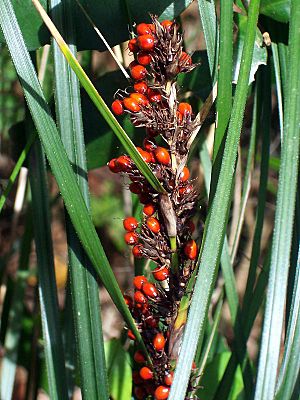Rough saw sedge
Quick facts for kids Rough saw sedge |
|
|---|---|
 |
|
| Scientific classification | |
| Genus: |
Gahnia
|
| Species: |
aspera
|
| Synonyms | |
Gahnia aspera is a plant often called the rough saw-sedge or round sawsedge. It's a type of plant that grows in clumps, like a big tuft of grass. You can often find it in places where the ground is a bit wet. Its long, strap-like leaves can grow up to 80 centimeters long.
Contents
About the Rough Saw-Sedge
How it Got its Name
The rough saw-sedge was first described by a botanist named Robert Brown in 1810. He called it Lampocarya aspera back then. Later, in 1825, a German botanist named Curt Polycarp Joachim Sprengel moved it to its current group, Gahnia. The name aspera comes from a Latin word meaning "rough," which describes how the plant feels.
What it Looks Like
Gahnia aspera grows as a clumpy plant, usually about 50 to 100 centimeters tall and 50 to 150 centimeters wide. Its leaves can be up to 80 centimeters long. Be careful when touching this plant! The edges and undersides of its leaves are very sharp and can easily cut your skin, just like a saw.
The plant produces creamy-colored flowers that grow in spikes from the center. These flowers usually appear from October to January. After the flowers, you'll see shiny red or reddish-brown round nuts. These nuts are small, about 4.5 to 6.0 millimeters long and 2.5 to 4.0 millimeters wide.
Where it Grows
You can find the rough saw-sedge in many different places. It grows in wet rainforests, but also in drier areas further inland. For example, it's found near Rankins Springs and in the Pilliga forest area in New South Wales, Australia. It also grows in Queensland, Malaysia, New Guinea, and on islands in the Pacific Ocean.
Plant and Animal Connections
This plant is important for several types of butterflies. The caterpillars of the spotted sedge-skipper (Hesperilla ornata), two-spotted sedge-skipper (Hesperilla malindeva), and flame sedge-skipper (Hesperilla idothea) all like to eat the leaves of Gahnia aspera.
Small birds, like the superb fairywren, also use the rough saw-sedge for shelter. Its dense, clumpy growth provides a safe hiding spot for them.
Growing and Uses
Growing in Gardens
Gahnia aspera is fairly easy to grow in a garden. It likes a moist spot and grows well in partial shade or even some sun. People like to grow it for its interesting leaves and the colorful nuts it produces. However, it's not super common in gardens because it can be tricky to grow new plants from its seeds.
Traditional Uses
Long ago, Aboriginal Australians used the seeds from Gahnia aspera. They would use these seeds to make a type of flour, which could then be used for food.

